
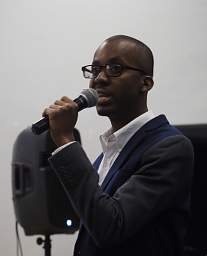
We arrived at the Windhoek, Namibia, airport about noon. There were three other World Teach volunteers on the plane, one of whom (Shawn) was the one for whom we had the extra visa. We made it through immigration with our makeshift visas, as did the rest of the volunteers. Bret McSpadden, the World Teach in-country director, met us and with a van and driver from the Ministry of Education got us transported to our home for the week, Backpacker Unite.
There were eight of us here for the summer, plus Bret:
In addition, Paavo Munenguni was with us as a summer IT intern.
 |
 |
| Bret | Paavo |
Our orientation included general group introduction / familiarity type activities, general safety, getting around Namibia, and an introduction to the Namibian educational system. Except for delivery to and return from our sites, we would be using general transportation, the same as ordinary Namibians. That mean public buses, taxis or hitch-hiking. Taxis and hitch-hiking are basically the same thing in Namibia -- you stand by the side of the road and wave your arm up and down at an approaching car, be it taxi or otherwise. It may be a normal taxi, an individual in a car, or a truck where you ride in the back. The cost is generally the same, regardless.
Our co-volunteers were a great bunch of bright, energetic young people. We always bring a game of Bananagrams with us on trips, and it was put to good use in the evenings.
We were broken into two groups and assigned responsibility for some of our meals. We got an overview of navigating around Windhoek in our vicinity, and a run-down on Namibian food supplies and groceries. We headed into town for some quick shopping -- needed food, and some items we would need once we arrived at our schools such as a sheets, pillowcases and some simple school / teaching supplies.
We got a quick introduction to Namibian culture, much of which Dona and I had already learned through research before arriving; and a discussion of culture shock, how to identify it, and some things to do when it starts happening. We also talked about difficult and awkward social, cultural and school situations and ways to handle them. That included topics like religion, sex, corporal punishment, gender bias, and alcohol. Much of that is similar to issues one would face teaching anywhere, but with interesting twists specific to Namibia. For those who hadn't had the experience before, we got an introduction to washing clothes by hand.
Dona, Jessica, Diane and Shawn were first up for fixing dinner. Dona helped everyone fix one of her signature dishes which our sons all love, a sausage casserole. It went over well, in spite of substituted ingredients.
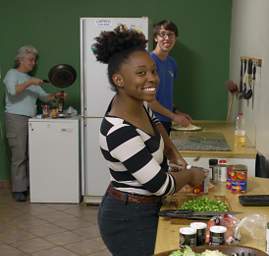 |
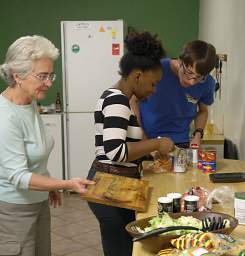 |
| Dona, Jessica and Fletcher
Working on Dinner in the Backpackers Unite Kitchen |
|
Individually, we talked about how we ended up in Namibia,; it was a good way to learn a bit more about each other. I was impressed with my fellow volunteers and what they had accomplished or been through so far in their lives. This was a group of thoughtful, tolerant, caring people.
We took an afternoon to travel to Katatura, one of the "settlements" on the outskirts of Windhoek. Literally translated from its Herero (one of Namibia's native peoples) origin, "Katatura" means "The place where we don't want to stay." Under the apartheid government prior to independence, the white government bulldozed existing settlements adjacent to the city and forced people to move to the Katatura area, then built an industrial park in between to enforce / delineate the separation.
Three months later, after traveling around the country more, it's pretty easy to see where that name comes from. Despite its dry, harsh landscape and difficult living conditions, Namibia is a beautiful country; I too would rather live "out there" than in Katatura, or even Windhoek itself.
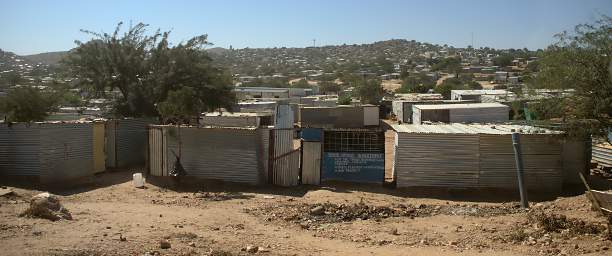 |
| Katatura |
We drove through Katatura to Penduka, a women's help and education program set up in 1992. Its aim is to empower women by teaching them a craft and educating them in the tourism industry, focusing on women who have health problems or are handicapped. Many of them are struggling with Tuberculosis and receive health education and medication as well.
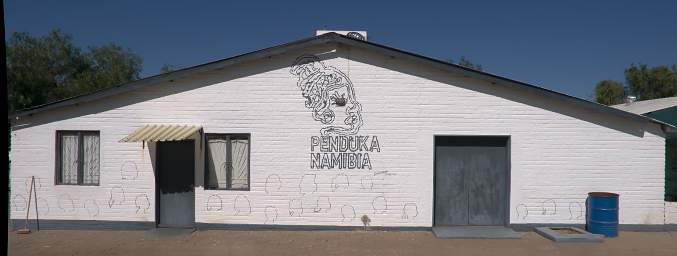 |
| Penduka |
The Penduka center is located on the lake behind Goreangab Dam. Also located on the lake is the world's first sewage treatment plant that produces potable drinking water that is actually used -- it's been in operation since 1968. According to Benedito Braga, President of the World Water Council, "The quality from the sewage is very good, as good or better than the tap water in any city in the developed world." It's more a cultural aversion than a technical problem, but with water shortages looming on the horizon, we need to get over some of our squeemishness. We have treatment plants like that in the U.S. as well, but the water isn't used for drinking because of our squeamishness. We enjoyed touring the Penduka grounds and looking at their interesting structures.
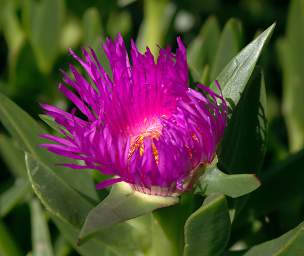 |
| A flower down by the lake |
Much of the work done at the center involves recycling, and there are various solar-energy related projects. Some of the buildings are made of recycled bottles in a kind of stackwall construction.
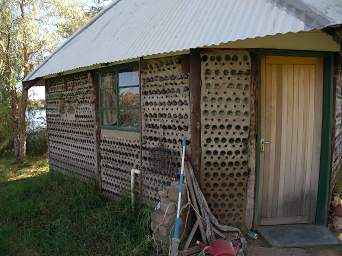 |
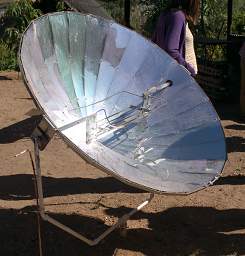 |
| Building with walls made using bottles | Solar BBQ |
They had some interesting pavilions made with concrete roofs supported by re-bar lattices, with skylights made of simple recycled pop bottles. Another one used rebar as a support mesh for a thin metal skin. The overall shape was particularly pleasing -- much more so than your regular rectangular shaped shelter.
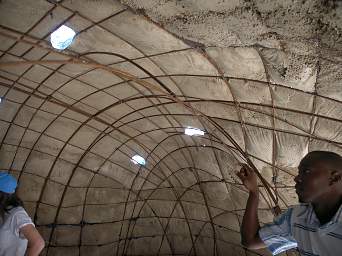 |
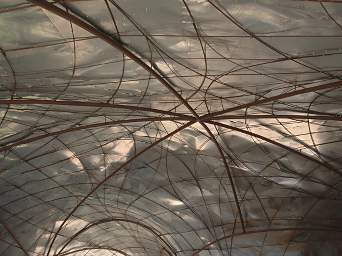 |
| Concrete, rebar and pop-bottle roof | Concrete and rebar roof |
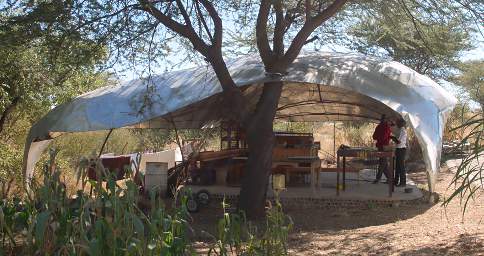 |
| Shelter of thin metal supported by rebar |
We watched as they made beads of recycled glass which are then used in jewelry. The had a sign out that said they needed red and blue glass; I have a blue bottle I could give them, but unfortunately it's not easy to get it over there...
The side of the building in which they did a lot of the bead work was painted with murals explaining the process from start to finish. I'm sure I have some of these steps wrong...
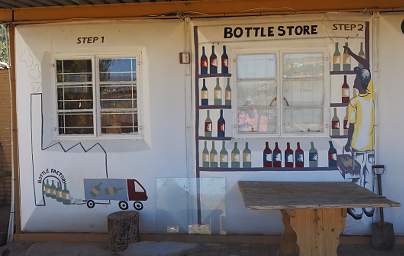 |
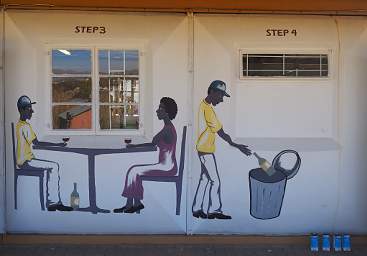 |
| Step 1: Bottles leave the Bottling Plant
Step 2: People buy whatever is in the Bottle |
Step 3: The contents of the bottle are used up
Step 4: The bottle is discarded / set aside for recycling |
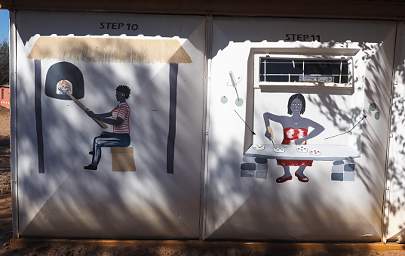 |
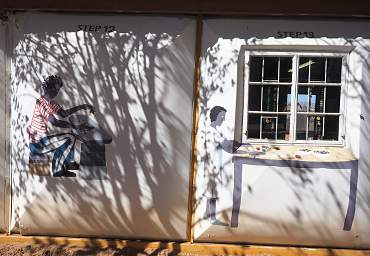 |
| Step 10: The Beads are Fired in a Charcoal Heated Kiln
Step 11: Beads are Removed from the Molds |
Step 12: The Beads are Sorted
Step 13: Beads are Selected for Specific Products |
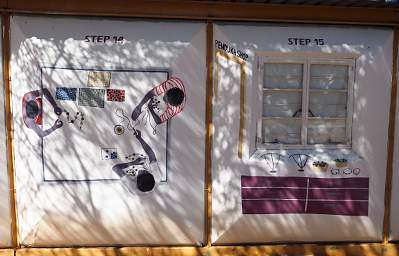 |
 |
| Step 14: Beads are made into Finished Products
Step 15: Finished Products are Displayed for Sale |
Step 16: You Buy them and Enjoy Wearing Them! |
They also had posted an article describing how the glass bead project got started.
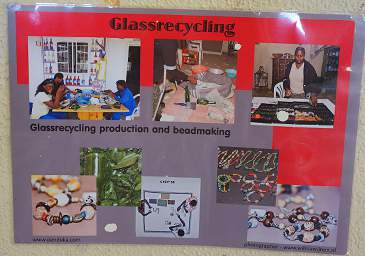 |
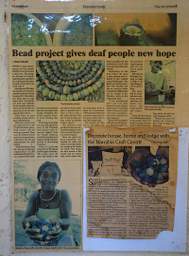 |
| Penduka Glass Bead Project | |
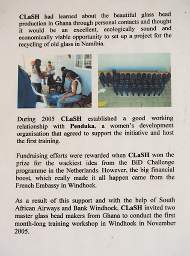 |
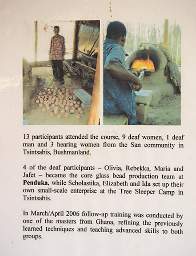 |
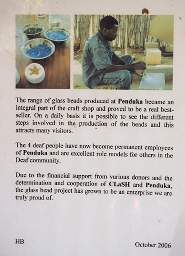 |
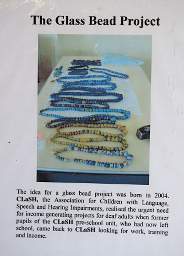 |
They were in the process of making some beads while we were there, so we got to see the molds and kiln in use.
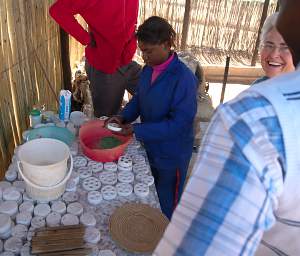 |
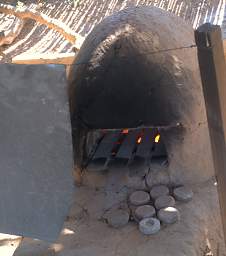 |
| Making Glass Beads | Firing Glass Beads |
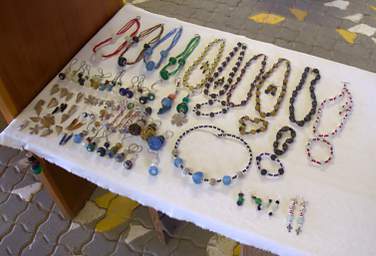 |
| Glass Bead Jewelry |
One evening some of us went out to the "Spoken Word," where we were treated to poetry by Namibians of widely differing backgrounds, like the country itself. Many of the pieces related to the continuing struggle for racial and social equality, and I enjoyed it a lot.
As I absorbed the words, silences and images pouring out, I came to the thought that if Namibia is to succeed as a nation (and I think they have a good chance of doing so), her people must identify first as citizens of the world; second as citizens of Namibia; and third as members of their tribe / culture. This is where the United States of America has failed -- we all claim to be citizens of America first, but many actually identify first (whether knowingly or not) as members of some smaller group -- the white Christian tribe, the black tribe, the Hispanic tribe, etc. Just as Iraquis or Afganis define themselves as Sunni or Shite first.
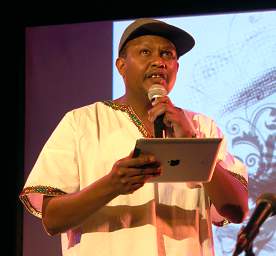 |
 |
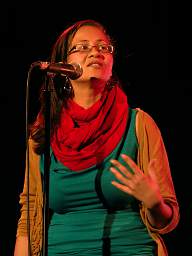 |
 |
|
| The Spoken Word | ||||
 |
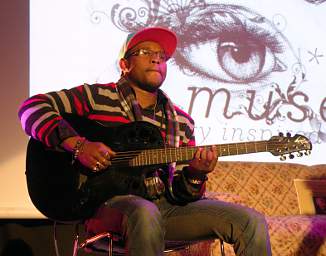 |
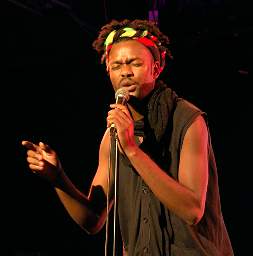 |
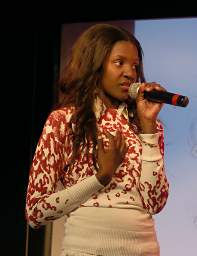 |
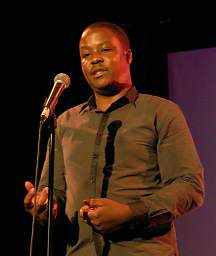 |
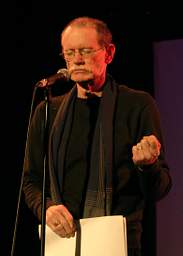 |
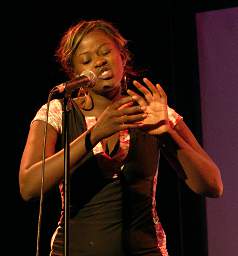 |
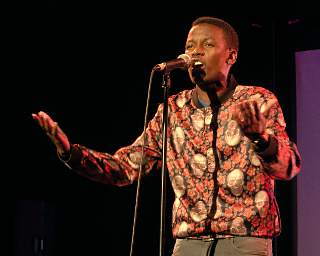 |
Windhoek is up on a plateau, and it was winter. In spite of the fact that Namibia is a generally warm country, it was cool. It was especially cool if you were just sitting around talking and not exercising. We all hauled our blankets out as our orientation progressed.
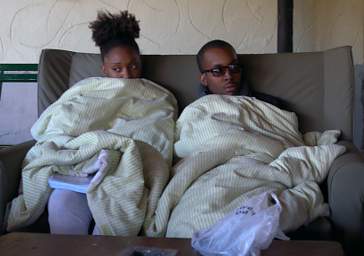 |
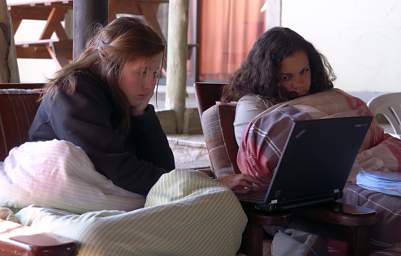 |
| Jessica and Paavo | Diane and Kathryn |
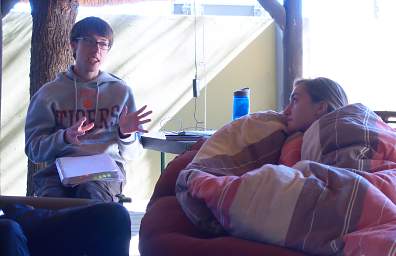 |
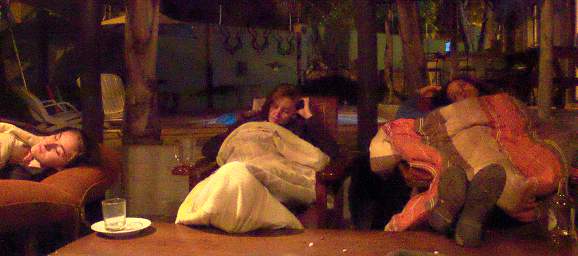 |
| Fletcher and Katie | Diane and Kathryn |
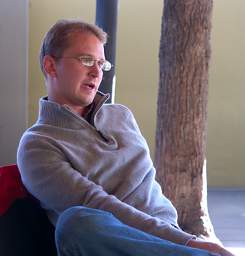 |
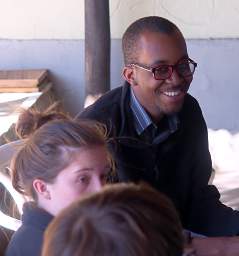 |
| Bret | Diane and Paavo |
As part of our orientation we visited the Ministry of Education, where we had a good conversation with the head of the Computing Support Center. He described a project they have for teachers consisting of seven modules for basic computer literacy. When they pass it, they get a free laptop. For a country where many teachers are computer illiterate, it seems like a good idea. He also showed us a portable computer classroom in a mobile shipping container. It was pretty cool, with solar panels on the roof to charge a battery storage system which then powered a server and a bunch of large-screen workstations on desks. A great idea, given the number of schools without power in remote places.
We met with the previous year's World Teach IT intern, and with an HIV/AIDS intern. It was a good opportunity to get their perspective on problems we might encounter at our schools and discuss ways to deal with them.
At various times during our orientation Musa, a local journalist / aspiring filmmaker, recorded some of our discussions and interviewed some of us. I don't know what became of the effort, but maybe it will show up somewhere, someday.
On our last night before heading out to our assignments, we went out on the town.
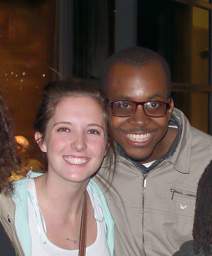 |
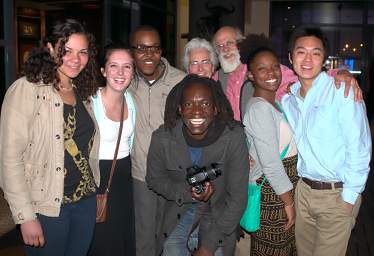 |
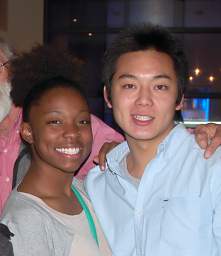 |
| Diane and Paavo | Kathryn, Diane, Paavo, Dona, Gary, Jessica, Shawn and Musa | Jessica and Shawn |
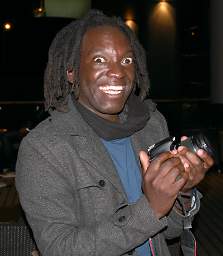 |
| Musa |
At dinner we sampled a side dish of "Garry", a blah, nondescript cream-of-wheat like mush. In retrospect, it was probably pearl millet, known locally as "Mahangu", and like cream-of-wheat, takes any additional flavor from sauces or anything else mixed in with it.
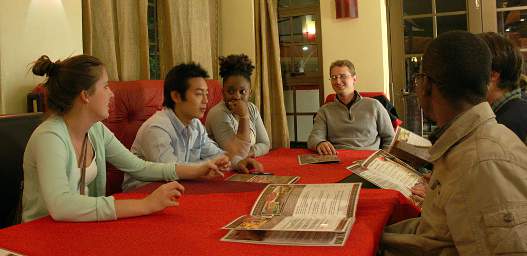 |
 |
| Dinner in Windhoek | |
Bret had a map of the Ohangwena region showing all the schools. I took a photo just in case it might prove useful, and marked on it where our cohorts at other schools would be. As you can see, we were all within a few kilometers of the Angola border. You'll also notice that a lot of the schools don't have any real roads going to them. The Ohangwena region is flat as a pancake and pretty much nothing but sand, and many of the villages have just tracks in the sand going to them.
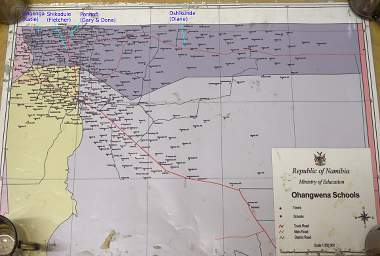 |
| Map of Ohangwena Schools |
We were all scheduled to head off to our individual school assignments the next morning, a Sunday. Jessica, Shawn and Kathryn got off at about 9:00, but our ride never showed up. Dona and I headed into town to try and find some last minute items we hadn't gotten earlier. Along the way we wandered into the "Bushman Art" store. They have an outstanding collection of tools and artifacts of people from all over Africa, particularly those native to Namibia.
 |
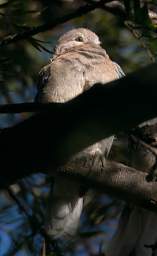 |
| Bret, driver Xxx, Jessica, Shawn and Kathryn
Heading down to Keetmanshoop and beyond |
Dove at Backpacker Unite
While waiting for the bus that didn't come |
Finally, on Monday our driver showed up. We all piled our stuff in and were off. It was our first chance to see any of Namibia outside of Windhoek; Dona and I eagerly peered out the windows.
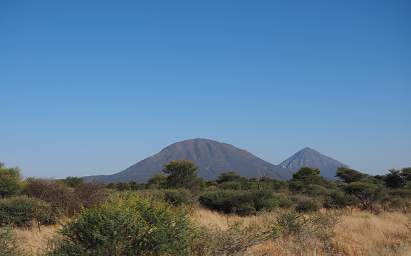 |
| North of Ondangwa
The only hills between Windhoek and Ohangwena |
Diane was supposed to get off with us at our school, where she would be picked and driven the 100 km or so to her school. When we were about an hour away we learned that wasn't going to happen. So we detoured to Eenhana which was 50 km closer to her school; someone from her school was going to drive over and pick her up. When we got to Eenhana, no one was there to meet her. At a little before 3 p.m. we left her on the sidewalk looking a bit apprehensive but with a smile.
We headed back west towards the main highway to Angola, where Fletcher and Dona and I were going to be. It felt weird to be heading west with the sun in the North! But that's the way it is when you're in the southern hemisphere.
We dropped Fletcher at Shikadule, where he had a brand spanking new duplex to move into.
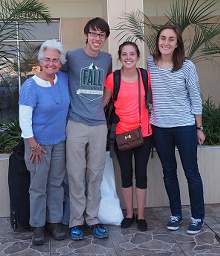 |
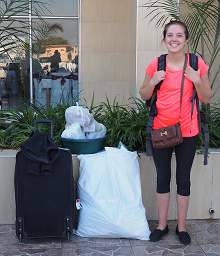 |
| Dona, Gary, Katie and Diane
Last seen together in Eenhana |
Diane
Alone and Wondering... |
 |
| Fletcher in his new digs
Fancy, spacious, and smelling of new paint! |
Then Dona and I got dropped at our house in Ohangwena near Ponhofi. That left Katie, who was going to Ongenga about 40 km away. Our driver was getting antsy about the lateness of the day, so we said goodbye and they headed off to deliver her before it got too dark.
Our living arrangement was a room in a house where another Ponhofi teacher lived with her family. The room had just enough space for a double bed, a small refrigerator (hooray!), a table, and a small closet. It would be cramped, but we weren't expecting much and soon got used to it.
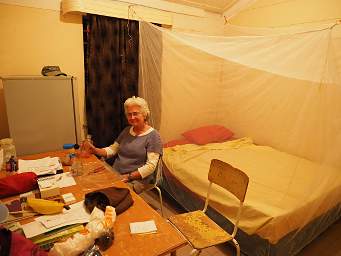 |
| Dona in our digs in Ohangwena |
Wow! We were here, and tomorrow would be our first day at our new school. I was pretty nervous.